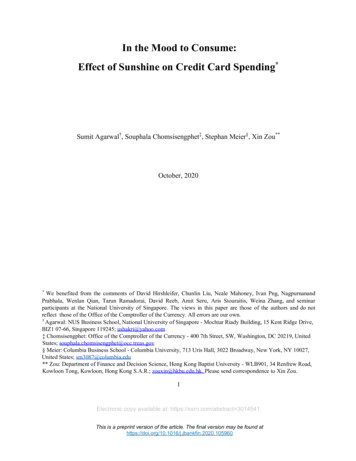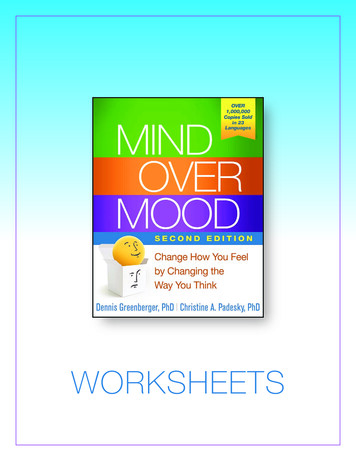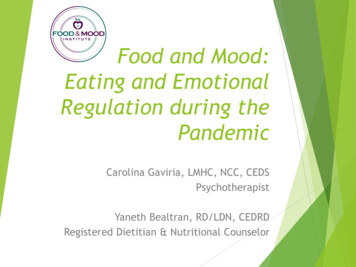
Transcription
In the Mood to Consume:Effect of Sunshine on Credit Card Spending *Sumit Agarwal † , Souphala Chomsisengphet ‡ , Stephan Meier § , Xin Zou **October, 2020* We benefited from the comments of David Hirshleifer, Chunlin Liu, Neale Mahoney, Ivan Png, NagpurnanandPrabhala, Wenlan Qian, Tarun Ramadorai, David Reeb, Amit Seru, Aris Stouraitis, Weina Zhang, and seminarparticipants at the National University of Singapore. The views in this paper are those of the authors and do notreflect those of the Office of the Comptroller of the Currency. All errors are our own.† Agarwal: NUS Business School, National University of Singapore - Mochtar Riady Building, 15 Kent Ridge Drive,BIZ1 07-66, Singapore 119245; ushakri@yahoo.com‡ Chomsisengphet: Office of the Comptroller of the Currency - 400 7th Street, SW, Washington, DC 20219, UnitedStates; souphala.chomsisengphet@occ.treas.gov§ Meier: Columbia Business School - Columbia University, 713 Uris Hall, 3022 Broadway, New York, NY 10027,United States; sm3087@columbia.edu** Zou: Department of Finance and Decision Science, Hong Kong Baptist University - WLB901, 34 Renfrew Road,Kowloon Tong, Kowloon, Hong Kong S.A.R.; zouxin@hkbu.edu.hk. Please send correspondence to Xin Zou.1Electronic copy available at: https://ssrn.com/abstract 3014541This is a preprint version of the article. The final version may be found athttps://doi.org/10.1016/j.jbankfin.2020.105960
In the Mood to Consume:Effect of Sunshine on Credit Card SpendingOctober, 2020AbstractUsing a large, representative sample of high-frequency credit card transactions in the UnitedStates, this paper examines the causal effect of sunshine-induced mood on contemporaneoushousehold credit card spending. We document a 0.3 percent increase in credit card spending inresponse to a one-unit increase in the same-day local abnormal sunshine. The spending responseis stronger forconsumers with higher credit card debt, lower FICO score, and shorter tenure with the bank. Theeffect manifests in long-term, durable goods spending, and is not driven by other weatherconditions, complementarity between sunshine and consumption, or intentional choice ofconsumption time. We document similar responses of spending on seasonal and non-seasonalgoods and during times with high and low sunshine levels. Finally, the sunshine effect occursamong consumers with various characteristics.Keywords: Credit Cards, Mood, Sunshine, Household Finance,Consumption JEL Classification: D12, D14, E21, H31
2Electronic copy available at: https://ssrn.com/abstract 30145411. IntroductionConsumption accounts for over 50 percent of GDP in many countries, and this number hasrisen to almost 70 percent in the United States since the 2000s ( World Bank , 2019). Given thelargestake, investigating the factors that influence household consumption is an economicquestion of first-order importance. Besides the income shocks that typically occur at relativelylow frequency,an often ignored factor is the mood.On the one hand, mood shocks can be highly volatile and frequent, and have a substantialaggregate impact. Therefore, studying the mood effect on consumption offers a morecomprehensive understanding of individual consumption decisions. As Loewenstein (2000)writes, “Understanding the emotions people experience at the time of consuming, or deferringconsumption, is critical for understanding and predicting the intertemporal trade-offs they make.”On the other hand, consumption fluctuations caused by mood, especially overconsumption, couldcontribute to household indebtedness. The growth of revolving debt is a major contributor to therapid accumulation of household debt in recent decades. The fraction of US revolving debt wasapproximately 40% in 1999, and has remained around 30% in recent years ( Federal Reserve ,2019).Given the generally high interest rate for revolving debt (for example, credit card debt),households with large amounts of revolving debt typically bear this burden for a lengthy period.In this sense, understanding the mood effect on household consumption has importantimplications for policies that target the household over-consumption and debt accumulation.Despite its importance, it is empirically challenging to identify the causal relationshipbetweenmood and consumption. Reverse causality and omitted variable concerns both adddifficulty to the identification. Specifically, individuals may change their consumption behavior
in response to mood fluctuations or, conversely, the consumption of goods may effectivelychange the consumer’s mood, leading to the reverse causality problem. On the other hand,omitted variables, such as income or economic trends, can potentially affect the individual’smood and consumptionat the same time. In this sense, a valid identification calls forhigh-frequency exogenous mood shocks, together with the corresponding consumption records atthe individual level. This paper attempts to study the causal effect of mood on individualconsumption using a proprietary dataset that combines the daily individual-level credit cardspending and the exogenous variations in local sunshine.1Electronic copy available at: https://ssrn.com/abstract 3014541Exploiting the mood changes induced by exogenous local sunshine shocks can largelymitigate the reverse causality problem. Psychological studies have documented the effect ofsunshine oninducing positive mood, which in turn affects the individual’s judgment andbehavior in various respects. 1 Moreover, the literature has also shown that individuals in a goodmood tend to be more optimistic and think in a heuristic way. This, in turn, leads to moreoptimistic choices and higher evaluations in many perspectives, including life satisfaction, pastexperience, and consumerproducts. 2 Consistent with those findings, financial studies havedocumented that investors tend to be more optimistic during high-sunshine times and depressedand more conservative during low-sunshine times, which gives rise to a significant positiverelation between stock returns and local sunshine (Saunders, 1993; Hirshleifer and Shumway,2003; Kamstra, Kramer, and Levi,2003). Applying similar logic to the consumption, we expect that positive local sunshine shocksshall induce individuals’ good mood, leading to an over-optimistic evaluation of the goods valuewhile consuming; and negative sunshine shocks work oppositely. Therefore, we expect a positiverelation between abnormal local sunshine and individual consumption.Using a proprietary credit card transaction dataset from a large US bank that issues creditcardsnationwide, we are able to measure individual real-time consumption at the dailyfrequency. The high-frequency nature of both sunshine and credit card spending variations allowsus to study consumption responses to mood shocks on the same day, alleviating the omittedvariables concern from relatively low-frequency common factors such as income or economictrends. In addition to credit card spending information (including spending amount, time, and
goods category), the data also provide a rich array of consumer financial and demographiccharacteristics, including the residential zipcode, credit card debt, credit line, and credit score,etc., which allow us to further disentangle the economic mechanisms and explore heterogeneouseffects from different consumer groups. As a representative consumer spending instrument, creditcards play an important role in studies of household consumption behavior ( Japelli, Pischke andSouleles, 1998; Gross and Souleles, 2002).1 See studies by Cunningham (1979), Howarth and Hoffman (1984), and Kämpfer and Mutz (2013) for the sunshineas positive mood inducer. Positive mood induced by sunshine is shown to trigger more helping behaviors (Guéguenand Lamy, 2013) and romantic relationships (Guéguen, 2013), and even affects school enrollment choice(Simonsohn, 2010). On the other hand, a lack of sunshine is associated with depression (Eagles, 1994) and suicide(Tietjen and Kripke, 1994).2 See, e.g., Schwarz and Clore (1983); Schwarz (1990); Petty, Gleicher, and Baker (1991); Bless, Clore, Scjwarz,Golisano, Rabe, and Wölk (1996); Bless, Schwarz, and Kemmelmeier (1996); Wright and Bower (1992); Sinclair andMark (1995); Bagozzi, Gopinath, and Nyer (1999).2Electronic copy available at: https://ssrn.com/abstract 3014541The final merged sample covers over 2 million credit card transactions from more than125,000 consumers in 19,000 zipcodes of the United States, during the sample period from 1 stMarch to 31 st October in 2003. For each zipcode in the sample, we construct the time series ofsunshine proxy—the sky cover— using available sky cover i nformation from the closest weatherstation of the top 10 closest weather stations within a 1,000 km radius for each day. To removeseasonal patterns, we construct an abnormal sky cover m easure for each zip-day in the sample asthe deviation of sky cover o n that day from the weekly average sky cover d uring the same week of1998-2008 , w ith the same day of the year being the week center. This abnormal sky covermeasure captures exogenous sunshine variations in each zipcode at the daily level; and a lowerabnormal sky cover is associated with a higher abnormal sunshine.We first document that local abnormal sunshine significantly positively affects theindividual’s credit card spending on the same day. Specifically, a one-unit increase in abnormalsunshine (proxied by a one okta d ecrease in abnormal sky cover) leads to around 0.3 percentincrease in the same-day total credit card spending, controlling for individual time-varyingcharacteristics and individual and calendar-day fixed effects. This effect is statistically significantand economically large: a one-unit increase in abnormal sunshine is estimated to increase dailyspending by around 0.41 for an average individual or, equivalently, around 51,000 in total forthe over 125,000 consumers in our sample. This can translate to a 6.8 billion of additionalspending and a 3 billion of extra credit card debt from all US credit card holders during the 30
days with the highest abnormal sunshine. We also document a more pronounced sunshine effectfor individuals with lower self-control over consumption (proxied by higher credit card debt,lower FICO score, and shorter tenure with the bank), whose spending is more likely to beaffected by mood.We conduct several tests to investigate possible alternative explanations for the sunshineeffect.First, as sunshine can be correlated with other weather conditions—for example,high-temperature days or non-rainy days usually have higher levels of sunshine—the sunshineeffect we document could be attributed to the effect of other weather conditions. To dispel thisconcern, we residualize the abnormal sky cover r egarding three other abnormal weather variablesthat might affectspending: abnormal temperature, abnormal wind speed , and abnormalprecipitation . We find the effect of residualized abnormal sky cover, which is orthogonal to theeffects of the other three abnormal weather variables, remains strong and robust, whereas theeffects of the other three3Electronic copy available at: https://ssrn.com/abstract 3014541abnormal weather variables are statistically insignificant and economically small. This suggeststhat the sunshine effect is unlikely to be a recapture of other weather conditions’ effects. Thesunshine effect is also unlikely to be driven by extreme weather conditions that impede theconsumer’s ability to travel to shops, as the impact of abnormal sunshine remains strong after weexclude days with extremely low temperature, high wind speed, or high precipitation.Another possible alternative explanation for the positive relation between abnormal sunshineand consumption is that sunshine and consumption are complements. Specifically, people willconsume more entertainment goods on sunny days, the utility from which is higher whenconsumed on sunny days. This explanation predicts that the sunshine effect should be thestrongest for entertainment goods, which are direct complements for good sunshine weather.However, we find inconsistent evidence. When we decompose total spending into spending onnon-discretionary goods (including local transportation and supermarket goods), entertainmentgoods (includingentertainment and dining), and long-term goods (including travel, service,durable, and apparel), we find that the sunshine effect is driven by spending on long-term anddurable goods. In contrast,the effect of abnormal sunshine on entertainment goods spending is close to zero. As the sunshineeffect is mainly driven by spending on durable goods, which on average have a higher value than
other types of goods, individuals could intentionally plan the date for durable goods purchases.For example, one can check the weather forecast and intentionally shift the consumption ofdurable goods to the upcoming good-weather days, leading to higher spending on sunny days. Totest this possibility, we investigate the distributed lag effect of abnormal sky cover d uring the 3weeks before the consumption date, which is presumably the longest period for which one canobtain a relatively accurate weather forecast. We find that durable goods spending only exhibits alarge and negative response to abnormal sky cover o n the same day, whereas the responses toabnormal sky cover i n 3 weeks before the consumption date fluctuate around zero and are mostlystatistically insignificant. This suggests that the sunshine effect cannot be fully explained by theintertemporal shifting of durable goods consumption.Next, we discuss and disentangle two possible economic mechanisms for the sunshine effect.On the one hand, an abnormally high sunshine level may induce a good mood in consumers,which gives rise to an over-optimistic evaluation of the value of goods and overconsumption ingeneral (Hirshleifer and Shumway, 2003). On the other hand, it is also possible that individualsovervalue the salient sunshine-relevant features on sunny days, thus their purchase of (long-term)goods is4Electronic copy available at: https://ssrn.com/abstract 3014541overly affected by the preference on the consumption date, leading to a projection bias/salienceeffect (Loewenstein, O’Donoghue, and Rabin, 2003).The projection bias/salience mechanism directly predicts that the positive sunshine effectshould be driven by the “seasonal goods” during the summertime, which are more likely to havesunshine-relevant features; whereas the over-optimism mechanism predicts a significant responsefor both seasonal goods and non-seasonal goods during both summer and non-summer times.Moreover, the projection bias/salience mechanism would predict that the positive relationbetween abnormal sunshine and consumption is concentrated during times with high sunshinelevels, when sunshine-relevant features are more salient and valuable. In contrast, theover-optimism mechanism predicts that the sunshine effect shall present in both high-sunshineand low-sunshine times, as long as the abnormally good sunshine can induce a good mood andover-optimism. The documented evidence is more consistent with the over-optimismmechanism. Specifically, we find that the spending response for non-seasonal goods is two timesof that for seasonal goods, and the positive sunshine effects during summer and non-summer
times are similar for both types of goods; we also document a similar (larger) response for totalspending (long-term spending) during low sunshine times for each zipcode.We document a significant sunshine effect on consumers with various demographiccharacteristics. Specifically, the sunshine effect is larger for consumers residing in zipcodes withlower average sunshine levels, where the marginal impact on mood from the same amount ofabnormal sunshine is higher. Males and females exhibit similar sunshine effects, but the spendingresponse to abnormal sunshine is larger for older and married consumers. This potentiallysuggeststhat consumers with lower financial constraints (and hence higher discretion over consumption)are more affected by the mood. We also document a significant positive relation betweenabnormalsunshine and the number of credit card transactions, but with a much smallermagnitude.Finally, we show that our findings are robust to alternative specifications regarding thestandard error clustering unit and the construction of daily sky cover . We also show that thedocumented sunshine effect is unlikely to be driven by spurious relations at the zipcode level.This paper directly contributes to the literature on the influence of mood on economic andfinancial decisions. Events associated with sentiment fluctuations, such as sunshine and sportingevents, are shown to affect local stock index returns through the impact on investors’ mood(Saunders, 1993; Hirshleifer and Shumway, 2003; Edmans, Garcia, and Norli, 2007; Kamstra,5Electronic copy available at: https://ssrn.com/abstract 3014541Kramer, and Levi, 2003). Agarwal, Duchin, Evanoff, and Sosyura (2013) records a significantimpact of sentimental events on the local loan approval rate, and Carroll, Fuhrer, and Wilcox(1994) document a significant positive relationship between consumer sentiment index andconsumer spending growth at the macro level. However, the unavailability of granular-levelindividual behavior information potentially generates higher noise in the match between the shock(i.e., sunshine) and the outcome (i.e., investment or consumption), making the causalidentification difficult. We contribute to this literature by directly linking exogenous localsunshine shocks to same-day credit card spending at the individual level. Confirmed credit cardspending measures granular consumer spending with a higher signal-to-noise ratio, andhigh-frequency analysis using both the time-series and cross-sectional variations largely facilitatesthe causal relationship identification.
We also contribute to the growing literature on the effect of environmental factors onconsumption. Earlier marketing and psychology studies conduct small-scale laboratory or fieldexperiments, and find that environmental factors, including sunlight, rainfall, temperature, andstore environment, significantly affect consumers’ purchasing behavior by modifying their mood(Donovan, Rossiter, Marcoolyn, and Nesdale, 1994; Spangenberg, Crowley, and Henderson,1996; Sherman, Mathur, and Smith, 1997; Parsons, 2001; Murray, Muro, Finn, and Leszczyc,2010). Recently, the availability of high-frequency spending data has allowed researchers toinvestigate this question among a larger scale of consumers. Studies document that weatherfactors, including temperature, sunshine, and rainfall, have a significant impact on the purchaseof specific types of goods, including cars, clothes, movie tickets, and mobile-push promotions(Conlin, O'Donoghue, and Vogelsang, 2007; Busse, Pope, and Silva-Risso, 2015; Buchheim andKolaska, 2016; and Li, Luo, Zhang, and Wang, 2017).We provide new insights for this literature in three respects. First, instead of focusing on oneparticular type of goods, our comprehensive credit card spending data allow us to estimate theoverall spending response in a large sample of consumers across the US. This directly generalizesthe sunshine effect to the overall (disposable) consumption of households. Moreover, based ondetailed goods-type information, we are able to disentangle the projection bias/salience and overoptimism mechanisms, which cannot be addressed by only investigating a specific type of goods.Lastly, the rich consumer characteristics information further enables us to investigate the6Electronic copy available at: https://ssrn.com/abstract 3014541heterogeneous effects on different consumer groups, which are seldom explored in previousstudies.More broadly, this paper is linked to the household consumption and indebtedness literatures.A large literature documents consumption responses to income shocks at the individual level. 3 Onthe flipside, overconsumption could result in the accumulation of household debt, which has beenshown to hamper the economic growth of a country (Glick and Lansing, 2010; Georgarakos,Haliassos, and Pasini, 2014; Mian and Sufi, 2015; Mian, Sufi, and Verner, 2017; Lee and Mori,2019). This paper shows that abnormally high sunshine significantly increases the individual’scredit card spending, which could contribute to the household debt accumulation, especially thehigh-interest credit card debt.
The rest of the paper is organized as follows. Section 2 describes our data and methodology;Sections 3 and 4 report the main results and additional analysis respectively; and Section 5concludes.2. Data and Methodology2.1. Raw data2.1.1. Consumption dataWe use a proprietary credit card transaction dataset obtained from a leading US financialinstitution that issues credit cards nationwide to measure daily individual consumption. By theend of 2016, this financial institution took more than 10 percent of all bank deposits in the US,and has a retail consumer base of around 46 million; its customer base is representative of the USconsumer population (see also the description in Agarwal, Liu, and Souleles, 2007). This datasetcovers more than 3 million credit card transactions from 1 st March to 31 st October in 2003, fromover 127,000 random, representative accounts in the institution’s customer base.This dataset provides transaction-level credit card spending information during the 8-monthsample period, including transaction amount, transaction date, and goods type. 4 In addition, we3 See, for example, Shapiro and Slemrod (1995, 2003), Souleles (1999), Hsieh (2003), Stephens (2003, 2006. 2008),Johnson, Parker and Souleles (2006), Agarwal, Liu and Souleles (2007), Parker, Souleles, Johnson, and McClelland(2013), Gelman, Kariv, Shapiro, Silverman, and Tadelis, (2014), Agarwal and Qian (2014, 2017), Di Maggio,Kermani, Keys, Piskorski, Ramcharan, Seru, and Yao (2017), Olafsson and Pagel (2018), Agarwal, Qian, and Zou(2020). Fora complete review of the literature, please refer to Browning and Collado (2001) and Jappelli and Pistaferri (2010). 4We can observe the merchant category code (i.e., MCC code) information for each transaction. The MCC code is astandard four-digit number assigned to the merchant to classify the type of goods or services it provides, hence weare able to know the category of goods bought in each transaction for an individual.7Electronic copy available at: https://ssrn.com/abstract 3014541observe monthly-level individual financial information, including credit line, credit card debt,FICO score , and tenure with the institution. We can also observe a rich array of demographicinformation, including the account holder’s residential zipcode, age, gender, and marital status.This wide range of consumer characteristics allows us to disentangle the underlying economicchannels and further explore the rich heterogeneity of the sunshine effect. 5Credit cards, and in particular bank cards (e.g., Visa, MasterCard, Discover, and Optimacards), represent the leading source of unsecured consumer credit in the US (Japelli, Pischke, andSouleles, 1998). According to the 2004 Survey of Consumer Finances, more than 70 percent of
US households had at least one credit card, and the median (mean) household credit card balancewas 2,200 ( 5,100) . Around 50 percent of bank card holders still concentrate at least 90 percent oftheir total general-purpose balances on a single card. As one of the largest consumer credit markets,total revolving credit balances in the US have exceeded 925 billion, and spending viageneral-purpose credit card accounts for 15 percent of GDP in 2014 ( Consumer Financial ProtectionBureau , 2015) .Additionally, studies have shown that compared with cash/check spending,households typically use cards to adjust their disposable consumption in response to shocks( Gelman, Kariv, Shapiro, Silverman, and Tadelis, 2014) . In this paper, we aim to investigate theindividual’s consumption response to same-day sunshine shocks; hence, individual-level creditcard spending serves as an important source to capture the consumption decisions.This dataset offers several advantages compared with previous studies based on survey data(e.g., Carroll, Fuhrer, and Wilcox, 1994) or specific types of purchases (e.g., Busse, Pope, andSilva-Risso 2015; Buchheim and Kolaska, 2016; Li, et al., 2017). First, relative to traditionalsurvey-based datasets such as the Survey of Consumer Finances (SCF) or Consumer ExpenditureSurvey (CEX), our administrative dataset captures consumption with little measurement error.The real-time confirmed customer spending largely mitigates the selection bias or response biasthat can arise from survey data. Moreover, relative to spending on a particular type of goods,credit5 Similar as in Agarwal, Qian, and Zou (2020), while our data only capture consumer spending through credit cardsfrom one major financial institution, it is important to note that our identification strategy does not require a completeaccount of all spending by the individual. To the extent that the choice of consumer spending instrument is exogenousto abnormal sunshine (i.e., consumers do not systematically choose to use cards from different institutions underdifferent sunshine conditions), the credit card spending in our dataset is an unbiased indicator of consumers’ overallconsumption. Since only 2 percent accounts in the whole dataset correspond to individuals with multiple credit cardaccounts with the institution, we will use “individual,” “consumer,” “customer,” and “account” interchangeably. Weverify that the findings are robust when we drop individuals with multiple accounts, or aggregate the spending at theindividual level.8Electronic copy available at: https://ssrn.com/abstract 3014541card spending that covers various types of goods allows for a more comprehensive estimation ofthe sunshine effect, and also enables us to disentangle the economic mechanisms. Additionally,the combined high-frequency credit card spending and local sunshine shocks for a large,representative consumer group is crucial for the causal effect identification. Lastly, the dataset’srich information on consumer characteristics empowers us to further investigate the heterogeneityof different consumer groups.
To serve our purposes, we aggregate credit card spending for each individual at the dailylevel. To capture “real” spending on goods, we exclude obvious bank-fee items such as latepayment fees, cash advance fees, over-limit fees, and financial charges. The dataset covers127,239 consumers from 20,179 zipcodes. To mitigate the possible influence of outliers, wewinsorize the credit card spending at 1 st and 99 th percentiles.2.1.2. Weather dataWe collect weather information from the Integrated Surface Data (ISD) on the NationalClimate Data Center’s website. 6 The raw weather data files report intra-day records for eightweather variables from weather stations nationwide: air temperature, dew point, sea-levelpressure, wind direction, wind speed, sky cover, one-hour accumulated liquid precipitation, andsix-houraccumulated liquid precipitation. Following the previous studies (Saunders, 1993;Hirshleifer and Shumway, 2003), we use sky cover as a proxy for sunshine. Sky cover r angesfrom 0 okta ( clear) to 8 oktas (overcast), and could be recorded several times within a day. 7 Weuse 6 a.m. to 10 p.m. as the relevant time period, during which individual consumption can beaffected by exposure to sunshine. In the main analysis, therefore, we use the average sky coverduring this period to construct the daily sky cover for each weather station, and a lower sky coveris associated with a higher sunshine level.2.2. Sample construction and summary statisticsWe construct the time series of sky cover at the zipcode level. Specifically, for each zipcodein the credit card spending dataset, we identify the 10 closest weather stations within a 1,000 km6 http://www.ncdc.noaa.gov/oa/climate/isd/ .7 Different weather stations have different recording times and frequencies for the weather variables.9Electronic copy available at: https://ssrn.com/abstract 3014541radius for each year during the period 1998-2008 (i.e., from 5 years before to 5 years after 2003). 8For each zip-day, we use the sky cover f rom the closest weather station as the local sunshineproxy; if the sky cover from the closest weather station is missing, we employ the sky cover fromthe second closest weather station, etc. We repeat this process until we have found non-missingsky cover f or a zip-day, or the sky cover i nformation from all of the 10 closest weather stations
within 1,000 km have been exploited. Based on this strategy, the sky cover value for each zip-daycomesfrom the record of the closest possible weather station, and the time-series of sky cover for azipcode can be a combination of sky cover information from several nearby weather stations. Weare able to construct sky cover time series for 18,829 zipcodes from the credit card spendingdataset, which covers 125,608 consumers.To remove seasonal patterns, we construct the abnormal sky cover m easure to captureexogenous sunshine shocks for each zip-day. Specifically, we define the abnormal sky cover i nzip z o n day t o f 2003 as the deviation of sky cover on day t f rom the weekly average sky cover o fthe same week during 1998-2008 , w ith the same day of the year being the week center: z z ztwhere z is the sky cover l evel at zipcode z o n day t; and zt i s the mean of skycover a t z in the [-3, 3] day window around day t f rom the yea
Using a large, representative sample of high-frequency credit card transactions in the United States, this paper examines the causal effect of sunshine-induced mood on contemporaneous household credit card spending. We document a 0.3 percent increase in credit card spending in response to a one-unit increase in the same-day local abnormal sunshine.










